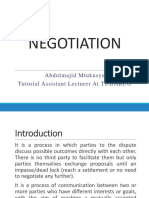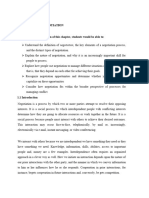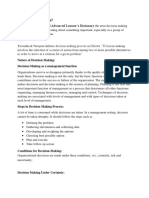Palawan State University
College of Community Resources Development
Balabac Campus
Elective 4 Negotiation – Module 3
The Nature of Negotiation
At the end of the chapter the students will be able to:
1. Understand the definition of negotiation, the key elements of a negotiation process, and the
distinct types of negotiation.
2. Explore how people use negotiation to manage different situations of interdependence—
that is, that they depend on each other for achieving their goals.
3. Consider how negotiation fits within the broader perspective of processes for managing
conflict.
4. Gain an overview of the organization of this book and the content of its chapters
Negotiation is a fundamental process of communication and decision-making in which two or
more parties with differing interests, goals, or perspectives work to reach a mutually acceptable
agreement. It is a dynamic, interactive, and often complex activity that involves various strategies,
tactics, and interpersonal skills. The nature of negotiation can be understood through its defining
characteristics, goals, processes, and contexts.
Key Characteristics of Negotiation
1. Mutual Interest and Conflict: Negotiation arises when parties share some common
interests but also have conflicting goals or positions. Both cooperation and competition are
inherent in the process, as each party seeks to satisfy their own interests while recognizing
the need for an agreement with the other side.
2. Interdependence: Negotiation typically occurs when parties are interdependent, meaning
that each party needs something from the other to achieve their desired outcome. This
interdependence can be symmetric (where both parties have equal power) or asymmetric
(where one party holds more power).
3. Voluntary Process: Negotiation is generally a voluntary process where the parties engage
willingly to resolve their differences. Although external pressures may prompt negotiation,
the parties must ultimately choose to participate.
4. Communication: Effective negotiation depends on clear communication between the
parties. Negotiators exchange offers, counteroffers, proposals, and information to influence
each other’s decisions and shape the outcome.
5. Bargaining: Bargaining is a central element of negotiation, where the parties exchange
concessions and seek to balance their demands with what they are willing to give up.
Negotiators aim to reach an agreement by finding a middle ground through compromise
and adjustment of positions.
pg. 1
SHYRREL SUNIO-DELA CRUZ
shysuniodelacruz@gmail.com / sdelacruz@psu.palawan.edu.ph
09217831959/09307494045/09668396433
�Palawan State University
College of Community Resources Development
Balabac Campus
Elective 4 Negotiation – Module 3
6. Goal-Oriented: Negotiation is typically goal-oriented, with each party seeking to achieve
a specific objective or set of objectives. These goals can vary widely, from resolving a
conflict, securing a business deal, to achieving a legal settlement or fostering diplomatic
relations.
Types of Negotiation
Negotiation can take different forms depending on the context and the objectives of the parties
involved:
1. Distributive Negotiation (Win-Lose): Often referred to as “zero-sum” or “competitive”
negotiation, this type focuses on dividing a fixed amount of resources. In distributive
negotiation, one party’s gain is the other party’s loss. The goal is to claim as much value
as possible for oneself, often through hard bargaining and positional tactics.
2. Integrative Negotiation (Win-Win): In integrative or “collaborative” negotiation, the
focus is on expanding the pie rather than dividing it. Parties work together to find mutually
beneficial solutions by identifying shared interests and creatively generating options that
provide value to all sides. This approach emphasizes cooperation, problem-solving, and
long-term relationship building.
3. Mixed-Motive Negotiation: Many real-world negotiations involve a mix of distributive
and integrative elements. In these situations, parties may need to compete over some issues
(distributive) while collaborating on others (integrative). Successful negotiators must be
adept at balancing competitive and cooperative strategies.
Goals of Negotiation
The goals of negotiation can vary, but they generally fall into three main categories:
1. Reaching an Agreement: The primary goal of most negotiations is to reach a mutually
acceptable agreement that resolves the conflict or dispute. This agreement should meet the
needs of both parties to the extent possible.
2. Maximizing Value: Negotiators often aim to maximize the value they receive from the
agreement. This involves getting the best possible outcome, whether it is in terms of price,
terms of the deal, or other favorable conditions.
3. Maintaining Relationships: In many negotiations, especially in long-term partnerships,
the goal extends beyond the immediate outcome to maintaining or improving the
relationship between the parties. Negotiators may prioritize preserving trust, cooperation,
and goodwill to enable future interactions.
pg. 2
SHYRREL SUNIO-DELA CRUZ
shysuniodelacruz@gmail.com / sdelacruz@psu.palawan.edu.ph
09217831959/09307494045/09668396433
�Palawan State University
College of Community Resources Development
Balabac Campus
Elective 4 Negotiation – Module 3
The Negotiation Process
The negotiation process typically follows several stages, although not all negotiations adhere
strictly to this linear progression:
1. Preparation: Effective negotiation begins with thorough preparation. This involves
gathering information, identifying goals, understanding the interests of both parties,
assessing the balance of power, and formulating a strategy.
2. Opening: The negotiation begins with an initial exchange of positions or offers. This stage
sets the tone for the negotiation and can involve both formal and informal communication.
3. Exploration and Discussion: During this stage, parties discuss their interests, needs, and
concerns. They may clarify positions, share information, and explore potential options for
agreement. This phase is crucial for identifying common ground and generating possible
solutions.
4. Bargaining and Concessions: Bargaining involves the exchange of offers and
counteroffers, with each party making concessions to move closer to a final agreement.
This stage requires skillful management of offers, deadlines, and the negotiation dynamic.
5. Closing: Once the parties have reached a tentative agreement, they finalize the details and
formalize the terms. This may involve drafting a contract, treaty, or other binding
agreement.
6. Implementation: After the agreement is reached, the parties move forward with
implementing the terms. This stage ensures that the negotiated solution is put into practice.
Contexts of Negotiation
Negotiation occurs in a wide variety of contexts, including:
1. Business Negotiation: In business, negotiation is critical for activities such as contract
negotiations, mergers and acquisitions, sales agreements, labor relations, and conflict
resolution.
2. International Diplomacy: Negotiation is a fundamental tool in diplomacy, used to resolve
disputes between nations, negotiate treaties, trade agreements, and handle international
crises.
3. Legal Negotiation: In the legal field, negotiation is often used to settle disputes out of
court through mediation, arbitration, or direct settlement discussions between the parties.
4. Personal and Social Negotiation: Individuals engage in negotiation in their daily lives,
such as in family disputes, community issues, or interpersonal conflicts. Negotiation in
these contexts often focuses on relationship maintenance and conflict resolution.
pg. 3
SHYRREL SUNIO-DELA CRUZ
shysuniodelacruz@gmail.com / sdelacruz@psu.palawan.edu.ph
09217831959/09307494045/09668396433
�Palawan State University
College of Community Resources Development
Balabac Campus
Elective 4 Negotiation – Module 3
Conclusion:
Negotiation is a complex and multifaceted process that involves managing conflicting interests
through communication, bargaining, and cooperation. Its nature is defined by interdependence,
competition, and collaboration, with the ultimate goal of reaching an agreement that satisfies
the needs of all parties involved. Skilled negotiators must navigate the intricacies of human
behavior, strategy, and communication to achieve successful outcomes across a wide range of
contexts.
Thank You!
pg. 4
SHYRREL SUNIO-DELA CRUZ
shysuniodelacruz@gmail.com / sdelacruz@psu.palawan.edu.ph
09217831959/09307494045/09668396433
























































































